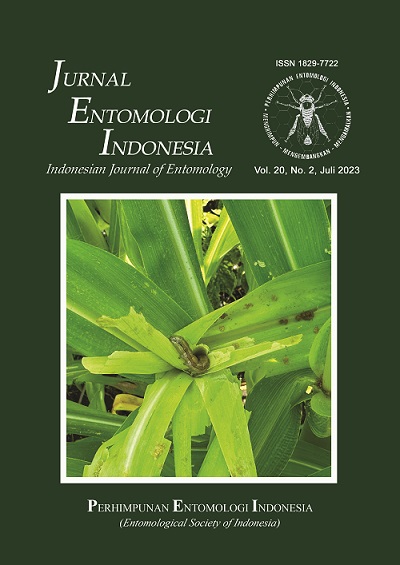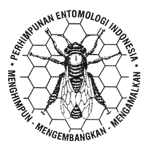Rapid assessments of the rice brown planthopper (Nilaparvata lugens Stal) outbreak in Semarang District, Central Java: Effects of farmers' low KAP
Belajar dari kajian cepat ledakan wereng coklat (Nilaparvata lugens Stal) di Kabupaten Semarang, Jawa Tengah: Pengaruh dari rendahnya PST petani
DOI:
https://doi.org/10.5994/jei.20.2.137Keywords:
neonicotinoid, planthopper outbreaks, pyrethroid, rapid assessment, resurgenceAbstract
Rapid assessments on the outbreak of rice brown planthoppers (BPH) (Nilaparvata lugens Stal) were conducted to investigate the status of BPH populations and the causative factors behind the outbreak. These assessments served as the basis for developing a proper action program. The assessments took place in Banyubiru Sub-District, Semarang District covering four villages (Kebondowo, Rowoboni, Tegaron, Kebumen) in December 2013. We analyzed BPH data, along with information about farmers' practices in managing pests collected through interviews conducted in January 2018 in Indramayu. Additionally, we examined data on the number of BPH-infested areas in Java from 2010 to 2020 and the stock of insecticides in Java in 2021. Simple statistical analyses were carried out. The BPH population had spread throughout Banyubiru and was present in all sampled plots. The average number of BPH eggs ranged from 115.25 to 379.65 per rice hill, while the BPH nymphs and imagoes ranged from 3.42 to 11.87 per rice hill. The relatively low nymphs to imagoes ratio might be influenced by the high BPH predator populations, which ranged from three to six individuals per rice hill. Suspected causes of BPH resistance and resurgence included the application of banned and improper insecticides, as well as the repeated use of the same insecticide active ingredients for an extended period. It is recommended to discontinue the mass spraying of insecticides to prevent further plant damage. In 2022, the Pest Control Movement has suggested replacing chemical insecticides with biological or natural pesticides. Intensive extension programs are strongly needed.
Downloads
References
Ali MP, Bari MN, Kabir MMM, Afrin S, Nowrin F, Islam MS, Landis DA. 2019. Establishing next-generation pest control services in rice fields: ecoagriculture. Scientific Reports. 9:10180. DOI: https://doi.org/10.1038/s41598-019-46688-6.
Aristyawan T, Muchtar R, Meidiantie D. 2020. Pengaruh agen hayati terhadap wereng batang cokelat (Nillavarpata lugens Stall) pada tanaman padi. Jurnal Ilmiah Respati. 11:69–74. DOI: https://doi.org/10.52643/jir.v11i1.863.
Baehaki SE, Mejaya IM. 2014. Wereng cokelat sebagai hama global bernilai ekonomi tinggi dan strategi pengendaliannya. IPTEK Tanaman Pangan. 9:1–12.
Bottrell DG, Schoenly KG. 2018. Integrated pest management for resource-limited farmers: challenges for achieving ecological, social and economic sustainability. The Journal of Agricultural Science. 156:408–426. DOI: 10.1017/S0021859618000473. DOI: https://doi.org/10.1017/S0021859618000473.
Catindig JLA, Arida GS, Baehaki SE, Bentur JS, Cuong LQ, Norowi M, Rattanakam W, Sriratanasak W, Xia J, Lu Z. 2009. Situation of planthoppers in Asia. In: Heong KL, Hardy B, (Ed.), Planthoppers: New Threats to the Sustainability of Intensive Rice Production Systems in Asia. pp. 191–220. Los Banos: International Rice Research Institute.
Chelliah S, Heinrichs EA. 1980. Factors affecting insecticide-induced resurgence of the brown planthopper, Nilaparvata lugens on rice. Environmental Entomology. 9:773–777. DOI: https://doi.org/10.1093/ee/9.6.773.
Dianawati M, Sujitno E. 2015. Kajian berbagai varietas unggul terhadap serangan wereng batang cokelat dan produksi padi di lahan sawah kabupaten Garut, Jawa Barat. Prosiding Seminar Nasional Masyarakat Biodiversity Indonesia. 1:868–873. DOI: https://doi.org/10.13057/psnmbi/m010437.
Dobermann A, Fairhurst TH. 2002. Rice straw management. Better Crops International. Special Supplement. 16:7–11.
Gorman K, Liu Z, Denholm I, Bruggen KU, Nauen R. 2008. Neonicotinoid resistance in rice brown planthopper, Nilaparvata lugens. Pest Management Science. 64:1122–1125. DOI: https://doi.org/10.1002/ps.1635.
Gunawan CS, Mudjiono G, Astuti LP. 2015. Kelimpahan populasi wereng batang coklat Nilaparvata lugens Stal. (Homoptera: Delphacidae) dan laba-laba pada budi daya tanaman padi dengan penerapan pengendalian hama terpadu dan konvensional. Jurnal Hama dan Penyakit Tanaman. 3:117–122.
Heong KL, Wong L, De Los Reyes H. 2013. Addressing planthopper threats to Asian Rice Farming and Food Security: fixing Insecticide misuse. ADB Sustainable Development working paper series No 27. DOI: https://doi.org/10.1007/978-94-017-9535-7_3.
[ISRI]. Indonesian Soil Research Institute. 2005. Pemupukan berimbang dengan perangkat uji tanah sawah V.01 (Balanced fertilization with Paddy Soil Test Kit V.01). Agro Inovasi. Bogor: Indonesian Center for Soil and Agroclimate Research and Development. Available at: http://ISRI.litbang.pertanian.go.id/ind/dokumentasi/ leaflet/puts.pdf [accessed 2021 July 29].
Iswanto EH, Susanto U, Jamil A. 2015. Perkembangan dan tantangan perakitan varietas tahan dalam pengendalian wereng coklat di Indonesia. Jurnal Penelitian dan Pengembangan Pertanian. 34:187–193. DOI: https://doi.org/10.21082/jp3.v34n4.2015.p187-193.
Kartaatmadja S, Soejitno J, Wardana IP. 1997. Pest management practices of rice farmers in West Java, Indonesia. In: Heong KL, Escalada MM (Eds.), Pest Management of Rice Farmers in Asia. pp. 87–98. Manila: International Rice Research Institute.
Khoa DB, Thang BX, Liem NV, Holst N, Kristensen M. 2018. Variation in susceptibility of eight insecticides in the brown planthopper Nilaparvata lugens in three regions of Vietnam 2015-2017. PLoS ONE. 13:e0204962. DOI: https://doi.org/10.1371/journal.pone.0204962.
Kuswoyo A. 2022. Pengendalian Hayati Wereng Batang Cokelat Menggunakan Bakteri Kitinolitik Asal Kantong Semar pada Tanaman Padi. Thesis. Bogor: IPB University.
Ma JF. 2004. Role of silicon in enhancing the resis-tance of plants to biotic and abiotic stresses. Soil Science and Plant Nutrition. 50:11–18. DOI: https://doi.org/10.1080/00380768.2004.10408447.
Matsukawa M, Ito K, Kawakita K, Tanaka T. 2015. Farmer perceptions and management of rice planthoppers in Cambodia. Japan Agricultural Research Quarterly. 49:103–109. DOI: https://doi.org/10.6090/jarq.49.103.
Matsukawa-Nakata M, Chung NH, Kobori Y. 2019. Insecticide application and its effect on the density of rice planthoppers, Nilaparvata lugens and Sogatella furcifera, in paddy fields in the Red River Delta, Vietnam. Journal of Pesticide Science. 44:129–135. DOI: https://doi.org/10.1584/jpestics.D18-080.
Nagata T. 2002. Monitoring on insecticide resistance of the brown planthopper and the white backed planthopper in Asia. Journal of Asia-Pacific Entomology. 5:103–111. DOI: https://doi.org/10.1016/S1226-8615(08)60138-7.
Norton GW, Heong KL, Johnson D, Savary S. 2010. Rice pest management: Issues and opportunities. In: Pandey S, Byerlee D, Dawe D, Dobermann A, Mohanty S, Rozelle S, Hardy B (Eds.), Rice in The Global Economy: Strategic Research and Policy Issues For Food Security. pp. 297–332. Los Banos; Philippines. International Rice Research Institute.
Prihandiani A, Bella DR, Chairani NR, Winarto Y, Fox J. 2021. The tsunami of pesticide use for rice production on Java and its consequences. Asia Pacific Journal of Anthropology. 22:276–297. DOI: https://doi.org/10.1080/14442213.2021.1942970.
Rashid MM, Jahan M, Islam KS. 2016. Impact of nitrogen, phosphorus and potassium on brown planthopper and tolerance of its host rice plants. Rice Science. 23:119−131. DOI: https://doi.org/10.1016/j.rsci.2016.04.001.
Ratna Y, Trisyono YA, Untung K, Indradewa D. 2009. Insect pest resurgence due to plants physiological and target insect changes after pesticides’ application. Jurnal Perlindungan Tanaman Indonesia. 15:55–64.
Ministry of Agriculture Republic Indonesia. Regulation of the Minister of Agriculture Number 39/Permentan/SR.330/7/201. 2015. Available at: http://perundangan.pertanian.go.id/admin/file/Permentan%2039-2015%20Pendaftaran%20Pestisida.pdf (in Indonesian) [accessed 2021 July 29].
Reissig WH, Heinrichs EA, Valencia SL. 1982. Insecticide-induced resurgence of the brown planthopper, Nilaparvata lugens on rice varieties with different level of resistance. Environmental Entomology. 11:165–168. DOI: https://doi.org/10.1093/ee/11.1.165.
Sianipar MS, Purnama A, Santosa E, Soesilohadi RH, Natawigena WD, Susniahti N, Primasongko A. 2017. Populasi hama wereng batang coklat (Nilaparvata lugens stal.), keragaman musuh alami predator serta parasitoidnya pada lahan sawah di dataran rendah Kabupaten Indramayu. Agrologia. 6:44–53. DOI: https://doi.org/10.30598/a.v6i1.245.
Sutrisno. 2014. Resistensi wereng batang cokelat padi Nilaparvata lugens Stål terhadap insektisida di Indonesia. Jurnal AgroBiogen. 10:115–124. DOI: https://doi.org/10.21082/jbio.v10n3.2014.p115-124.
Syahrawati M, Putra OA, Rusli R, Sulyanti E. 2019. Population structure of brown planthopper (Nilaparvata lugens, Hemiptera: Delphacidae) and attack level in endemic area of Padang city, Indonesia. Asian Journal of Agriculture and Biology. Special Issue:271–276.
Tan KH. 2009. Imidacloprid–From Hero to Zero in the Control of Brown Planthopper. Available at https://ricehopper.wordpress.com/2009/03/05/ imidacloprid-from-hero-to-zero-in-the-control-of-brown-planthopper/ [accessed 2021 July 29].
Trisyono YA. 2016. Pestisida di Indonesia: Where to go?. In: Winarto YT (Ed.), Krisis Pangan dan “Sesat Pikir”: Mengapa Masih Berlanjut?. pp. 45–63 Jakarta: Yayasan Pustaka Obor Indonesia.
Triwidodo H. 2020. Brown planthoppers infestations and insecticides use pattern in Java, Indonesia. AGRIVITA, Journal of Agricultural Science. 42:320–330. DOI: https://doi.org/10.17503/agrivita.v0i0.2501.
Uddin ABMA, Islam KS, Jahan M, Ara A, Afrin S. 2019. Farmer`s Perception about Resurgence of Brown Planthopper, Nilaparvata lugens (Stål) in Bangladesh. Bangladesh Rice Journal. 23:21–33. DOI: https://doi.org/10.3329/brj.v23i1.46078.
Wang YH, Gao CF, Zhu YC, Chen J, Li WH, Zhuang YL, Dai DJ, Zhou WJ, Ma CY, Shen JL. 2008. Imidacloprid susceptibility survey and selection risk assessment in field populations of Nilaparvata lugens (Homoptera: Delphacidae). Journal of Economic Entomology. 101: 515–522. DOI: https://doi.org/10.1603/0022-0493(2008)101[515:ISSASR]2.0.CO;2.
Yuantari MGC, Van Gestel CAM, Van Straalen NMV, Widianarko B, Sunoko HR, Shohib MN. 2015. Knowledge, attitude, and practice of Indonesian farmers regarding the use of personal protective equipment against pesticide exposure. Environmental Monitoring and Assessment. 187:142. DOI: https://doi.org/10.1007/s10661-015-4371-3.
Yulihastin E, Muhammad FP, Sofiati I. 2021. Oceanic Effect on Precipitation Development in the Maritime Continent during Anomalously-Wet Dry Seasons in Java. The Indonesian Journal of Geography. 53:328–39. DOI: https://doi.org/10.22146/ijg.63543.
Zhang X, Liu X, Zhu F, Li J, You H, Lu P. 2014. Field evolution of insecticide resistance in the brown planthopper (Nilaparvata lugens Stål) in China. Crop Protection. 58:61–66. DOI: https://doi.org/10.1016/j.cropro.2013.12.026.
Published
How to Cite
Issue
Section
License
Copyright (c) 2023 Hermanu Triwidodo, Bonjok Istiaji, Nurul Farida Efriani, Lilik Retnowati, Niky Elfa Amanatillah

This work is licensed under a Creative Commons Attribution 4.0 International License.
Authors who publish with this journal agree to the following terms:
- Authors retain copyright and grant the journal right of first publication with the work simultaneously licensed under a Creative Commons Attribution 4.0 International License that allows others to share the work with an acknowledgement of the work's authorship and initial publication in this journal.
- Authors are able to enter into separate, additional contractual arrangements for the non-exclusive distribution of the journal's published version of the work (e.g., post it to an institutional repository or publish it in a book), with an acknowledgement of its initial publication in this journal.
- Authors are permitted and encouraged to post their work online (e.g., in institutional repositories or on their website) prior to and during the submission process, as it can lead to productive exchanges, as well as earlier and greater citation of published work (See The Effect of Open Access).








